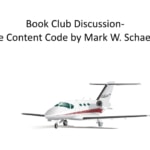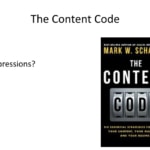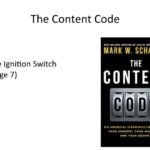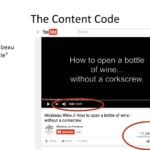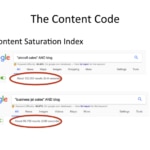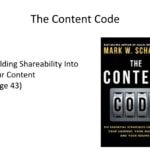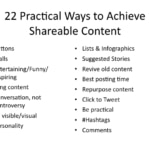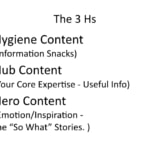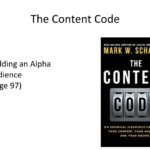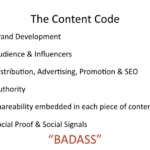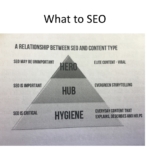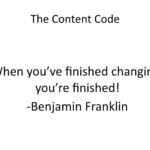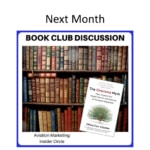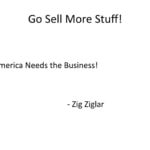John and I discuss Aviation Content Marketing while analyzing this month’s book, the Content Code by Mark W. Schaeffer.
The cover promises “Six Essential Strategies for Igniting Your Content, Your Marketing, and Your Business.”
Does it deliver for aviation content marketing? Well, I say “well, kind of,” and John says “no.”
Transcript – Aviation Content Marketing – Book Club Discussion of the Content Code by Mark W. Schaeffer
Paula Williams: So, welcome to this month’s book club conversation.
Today we’re talking about The Content Code by Mark W Schaefer. And this was actually kind of a surprise. We have a different book planned, but we weren’t able to get enough of them to work for our book club. So, this was a little bit of a surprise. I had not read the book before, so we took a little bit of a chance with this one and I think it actually turned out pretty good.
So, thank you for joining us and I’m Paula Williams.
John Williams: And I would be John Williams and we are ABCI.
Paula Williams: And ABCI’s mission is?
John Williams: To help all you ladies and gentlemen out there sell more products and services in the aviation world.
Paula Williams: Absolutely, so first impressions of the book, what did you think?
John Williams: Old hat.
Paula Williams: Old hat?
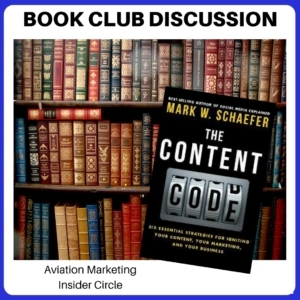 John Williams: Yeah this is what you’ve been espousing since I’ve known you and you’ve had your company running. With minor exceptions, and actually as I read through this, I think, roughly two-thirds of the way through it. It’s like there was something missing and I still don’t know what that was, but it’s like he missed whatever it was he was trying to hit the nail on the head.
John Williams: Yeah this is what you’ve been espousing since I’ve known you and you’ve had your company running. With minor exceptions, and actually as I read through this, I think, roughly two-thirds of the way through it. It’s like there was something missing and I still don’t know what that was, but it’s like he missed whatever it was he was trying to hit the nail on the head.
And I don’t know what it was because he said all the stuff that you’re already saying you tell all your people.
Paula Williams: Right, well it’s interesting because I was kind of excited about the book because the premise is that it’s a nice follow-on to Laura Hamley’s book about content that converts. So for aviation content marketing, both are important!
That was last month’s book, and it started with quality content or started with the assumption of quality content which, for this book, that just assumes that’s table stakes, right?
John Williams: [LAUGH] Right.
Paula Williams: [LAUGH] Okay, you’ve got fabulous content, if you don’t have fabulous content, then you’re just out of the game anyway.
John Williams: That’s right, you’re not in the game.
Paula Williams: Right, so I thought Laura Hanley’s book was fabulous for that purpose and then this book. The promise of it was to kinda pick up where that one left off and say, okay, now you’ve got fabulous content, but you’re having a hard time getting enough readers, or listeners, subscribers or friends or fans, or whatever you call them.
This is supposed to be the missing piece for that and I don’t know that it necessarily fulfilled on that promise. I was expecting maybe something more. You agree?
John Williams: Yeah I’m not sure I know what it was but, towards the end of it, the thing I got out of it was that nobody really knows what’s going on.
Paula Williams: Mm-hm nobody has the content code figured out.
John Williams: Well, they may think they do, but the problem is, as he says, there’s so much out there. That you’re trying to get people to read it without selling anything and then Google’s trying to do their thing. Google’s making it worse because they don’t know what they’re doing either.
They think they do, but doing what they do, then everybody with content’s doing what they do, and I think it’s a vicious circle. You’re lucky in some respects if you actually get somewhere, particularly is you are starting.
Paula Williams: Right, so content shock is what he calls it actually in the first chapter.
John Williams: Right.
Paula Williams: He talks about the ignition switch and that being where your content and your audience match up. And most people have great content, but they don’t have a great audience to start with. And that’s really the missing piece. One example that he talks about, the Mirabeau miracle.
John Williams: Right.
Paula Williams: This is a, people see just one little piece of a story and, in this case, we’ve got like a 49 second video that went viral, right? And it got 11 million views which is fabulous on YouTube. What they don’t tell you or what you don’t see in that sense, I mean this is a person who has a winery and is using content to sell wine, which is fabulous.
You know, it has a really cool business model and has a really engaging personality, has a lot of things you need to make this happen. But what you don’t see is that there were two or three years of work ahead of this video.
John Williams: Right.
Paula Williams: Of doing little videos every single week.
And doing the pedestrian work of acquiring an audience one person by one person. And responding to comments. And doing all of the things that they talk about in the book to make this happen. So, this is the ten-year overnight success story.
John Williams: Just because it went viral and had 11 million views does not mean he made 11 million sales.
Paula Williams: Exactly, he talks about the example of getting an article published or re-tweeted by Guy Kawasaki who has a Twitter audience the size of France. You remember that story? [LAUGH] And all it did was crash his servers. And none of those people ended up being customers or even repeat subscribers.
It didn’t have any long term effect on Mark Schaefer’s business, right?
John Williams: Mm-hm.
Paula Williams: So going viral really isn’t the goal here. The goal here is to build an audience and to make sales. So a lot of people get this confused. And a lot of the folks that I talk to day-in and day-out, they’re just like, what do I have to do to get these kinds of results, to get something to go viral.
And I’m like-
John Williams: It’s an accident.
Paula Williams: Yeah, that’s not the goal.
John Williams: [LAUGH]
Paula Williams: [LAUGH] We need to keep our eye on the ball here, and-
John Williams: If you could do one of those that goes viral, and actually have a CTA in it.
Paula Williams: Mm-hm.
John Williams: Then you might have accomplished something.
But you can’t, those things never happen with a call to action.
Paula Williams: Right, well the difference between the Mirabeau Miracle and the Guy Kawasaki re-tweet, between those two stories, were that he built up to this. So, the thought behind Mirabeau Wine was to collect people who have an interest in this and not just borrow an audience from a celebrity and build the numbers that way.
So this was kind of a natural building and a organic and over time, and a long-term strategic building, the other one it was simply an accident, happy accident, and the long-term strategy worked the happy accident didn’t in terms of sales.
John Williams: Hope is not a strategy.
Paula Williams: Hope is not a strategy, right.
Okay, so let’s talk about what you were talking about before and that is content saturation, right? So, there is a way that he puts forth in the book that I think it’s kinda clever to figure out the content saturation index of any particular topic, right?
John Williams: Yeah, as long as the clever doesn’t overcloud what’s real.
Paula Williams: [LAUGH] That’s true. The neat thing about aviation is that it is such a niche topic. That there are very few things that are really going to have content saturation are going to hit that point. The problem is that all of our customers are living in other worlds besides aviation.
In fact, we were talking earlier today, John, about how you’re just tired of content all together, not necessarily aviation content but just getting hit with everything.
John Williams: Exactly, if I do a search on the web and then the product or service page comes up, they better sell me within about 10 seconds or 15 seconds.
Because I’m not going to go any further, I don’t have to, somebody else will have it. I mean, I do all this with you and I see all this going on, but that’s not me, and I know I’m a different kind of guy, but still.
Paula Williams: [LAUGH]
John Williams: I read for pleasure and I read financial stuff to keep us afloat, and I read technical stuff from the IT perspective, and that’s enough.
[LAUGH] There’s a lot to read just to keep things going.Paula Williams: You don’t go seeking out videos on how to open a bottle of wine with your shoe?
John Williams: No, I mean, I look at videos, but the videos I look at, if they’re more than about 10 to 15 seconds, I don’t do it.
Paula Williams: Interesting.
John Williams: But that’s just me.
Paula Williams: Right, exactly, okay, so.
Paula Williams: All right, let’s go back to this Content Saturation Index. And the formula that he suggested, is to you use your keyword in quotation marks, and the word and blog or and podcast. Or, and whatever medium it is you’re anticipating to use as your primary content medium, right?
Okay, so this one is air charter and blog, and you can see there’s over a million results so-
John Williams: Almost 2 million.
Paula Williams: Right, exactly, almost 2 million results. Which makes you think, hm if I want to start a blog about air charter, I may be facing a more uphill battle than I would have been years ago, right?
John Williams: Well, on top of that, I may have misread the book or misunderstood but I get the feeling that his premonition or whatever it is that blogs basically is not where you’re going to get the data you want anyway.
Paula Williams: Exactly, you could do podcast, or you may find that your niche is saturated but there’s no podcasts there.
Or you may find that your niche is saturated, but there’s no videos there, there’s no YouTube channel there. So there’s always a way to do what you want to do, you just have to find a way that somebody else isn’t already-
John Williams: Doing in that niche.
Paula Williams: Exactly, glommed onto and locked up the entire audience.
Okay, so one thing you can also do is make it more specific. So if you did private air charter and blog, so that’s a small change. But it’s a big change to the type of content you might want to do, right? So you focus a little bit more and you’ve got a quarter of that saturation level, right?
John Williams: Well, 50,000 is less than a quarter, I’ll tell you that. That would have been a quarter of a million. That was even less than that, 50,000.
Paula Williams: Yeah, that’s right, I’m reading it wrong, I had the decimal in the wrong place.
John Williams: Like 4%.
Paula Williams: So 50,000 versus 2 million, you have a much better chance of getting quality content read by people who have an interest in private air charter, right?
John Williams: Yeah, that’s about two and a half percent.
Paula Williams: Cool, exactly, so that is a way to really target the opportunity and to find out. If you’re determined, you want to do a blog, which a lot of people are really good at writing. And just because he says blogs may be passe, if that is what you really want to do, you can find a way to find some space in a crowded marketplace.
John Williams: Sure.
Paula Williams: Cool, and that’s a really interesting way of doing it. Let’s do one more of those, let’s go aircraft sales, a very crowded field, right? Actually, not nearly as crowded as air charter, but still.
Paula Williams: 122,000 results, lots of people writing about aircraft sales. But if you say business jet sales, as opposed to Mooneys or Pipers or Bonanzas or King Airs or anything like that, there’s 39,000 versus 122,000.
So once again, you can find an easier place to make your mark or find an easier way to find an audience that isn’t saturated with content, right?
John Williams: Yes.
Paula Williams: Cool, okay, so that’s content saturation index, and that is actually very, very smart, to find a way to make sure that there’s enough of an audience there without too much competition.
Once again, kinda the prime directive in marketing is high demand, low supply, right?
John Williams: Yes.
Paula Williams: Okay, so this tells you what the supply is, and then the other side of that is you want to look at the demand, see how many people are looking for those keywords. But that’s an SEO topic that we’ve covered in great detail in other book conversations, right?
John Williams: Absolutely.
Paula Williams: Okay, cool, all right I did like the way he broke out the three Hs, right, Hygiene Content, Hub Content, and Hero Content. Hygiene content, I actually don’t really like that word I like- [LAUGH]
John Williams: That will be that just didn’t click.
Paula Williams: I like the term information snacks, so that’s what we call it in our practice but it’s the same thing as what he’s talking about with the hygiene content.
So basically, nobody, I mean, everybody’s like John, right? Nobody is willing to spend more than 15 seconds on a topic unless it really catches their interest. So a lot of times if we have a complex topic, we really need to break that down into neat little factoids, or something interesting to capture their attention.
And maybe teach them something they didn’t know, without them feeling tired, right? Looking at the big block of text or a horrible, long video or something like that. Okay, so that’s hygiene content, we do that several times a week. A good example of that is our digital marketing program where we do the information snacks for that kind of thing.
Hub content, though, can be longer, and I have seen Mr. Williams himself spend an hour in a webinar on a topic that’s of interest to him, right?
John Williams: When have you seen such a thing?
Paula Williams: Last week, we went to a webinar-
John Williams: Surely such a travesty that-
Paula Williams: [LAUGH] Has never occurred.
John Williams: To quote a movie.
Paula Williams: Exactly, no we attended a webinar on search engine optimization that was put on by SEMrush. If it is a topic that you’re interested in, I think every 15 seconds earned the next 15 seconds. So you’re always in danger of people leaving if your content isn’t interesting.
But you can do long form content, and those people are more likely to be buyers because they’re seriously interested in your content. And you don’t really want to get people addicted to the sugar high, you want to have kind of a balanced diet here, right? [LAUGH] And so, the information snacks are great, but every once in a while you gotta throw people some meat and potatoes, right?
John Williams: [LAUGH] That’s an interesting way of saying it but yes.
Paula Williams: Okay, and then the hero content, this is kind of the mythical unicorn of what everybody wants to do. But it really has to built on a foundation of the other two, right?
Paula Williams: So you look at some of the really great marketing that’s happened, the Budweiser Clydesdale commercials with the puppy [LAUGH] .
That’s emotional, inspirational, really great stories that may or may not have anything to do with the product, but that really connect with the brand. And that’s the sort of thing that we aspire to, but you can’t start there. You have to have really great hygiene content, hub content, you really have to engage.
Budweiser has invested millions of dollars, possibility billions of dollars. In their marketing infrastructure, their distribution plan, their business to business marketing, their meat and potatoes, and the information snacks. To get to the point where they can successfully do that type of hero content. So a lot of people want to start there, isn’t going to work right?
John Williams: You gotta crawl before you run.
Paula Williams: Yep, absolutely, and we should think in terms of this, so what? Why are we doing what we’re doing? We’re doing what we’re doing because we believe in the aviation industry. And we believe that there’s a lot of really crappy marketing in the aviation industry, and it’s taking people’s money and destroying people’s lives.
[LAUGH]John Williams: You don’t have to just believe it, you can see it.
Paula Williams: Exactly, so that’s what gets us up in the morning and gets us moving on saving customers from bad marketing. And having their business fail because they’re spending money on random acts of marketing. And that is kinda the so what to me, and maybe we don’t say that enough.
So what I pulled from that book that we should do differently, probably, is more of the so what, right?
John Williams: Do you need that everywhere in life?
Paula Williams: Absolutely, yeah, otherwise it’s just technical. You can be very successful based on the other two, but you don’t get the so what.
Why are we here, why are we doing this?
John Williams: And you’ll be eminently more successful if you can answer the so what appropriately.
Paula Williams: Absolutely, all right, so, next section that I thought was really cool, building shareability into your content. This is kind of the nuts and bolts of what’s useful about this.
You assume you have great aviation content, if you don’t have great content, go read Laura’s book again [LAUGH] and work through that. But assuming you have great content and you still don’t have a fabulous audience, there’s a lot of things that you can do. And, I know probably, some of these stand out more than others, depending on what you’re doing and what your situation or interest is, right?
John Williams: Yes.
Paula Williams: So, which of these was the most interesting to you?
John Williams: None of the above.
Paula Williams: None of the above, okay.
John Williams: If it’s interesting, I don’t need to be, I mean, you have to have something there so I can share it with somebody. But don’t try to convince me to share it whether I like it or not.
Paula Williams: Right but it does have-
John Williams: Yeah but that’s just me, that’s not life.
Paula Williams: Yeah but it has to come across your horizon right, so it has to hit you at a time when you happen to be reading.
John Williams: Well when I’m reading it and then I like it, I say, I think Joe would like to see this.
Then I need to be able to see a button somewhere I can push and type in his email address.
Paula Williams: Absolutely, one thing I kinda disagreed with was, he said knock down all the walls. I actually like having some gated content behind a wall that you have to put in some contact information for it.
It has be very high value content, or at least high perceived value content. Lead magnets, like checklists, tip sheets, ebooks, and other kinds of things. He says you should just give all that away. I think there’s a fine line there, and I think that some folks that are qualified aviation customers are going to have a better reaction to something that they have to do something for.
That causes them to pause and think, do I really want this checklist or am I just curious? Am I actually going to do something with this or not? It’s a two way street.
John Williams: Exactly.
Paula Williams: So I disagree on the walls item.
John Williams: Good.
Paula Williams: We’re not going to talk about all of these items but I think there is a lot to be said for especially repurposing content.
I started adding some of our older courses to Slideshare, just to get more mileage out of them. Because of some of the just statistics that he gave on how to get more eyeballs on old content using the same materials. And so, if you can do that with not much more effort, by all means, repurpose right?
John Williams: Mm-hm.
Paula Williams: Cool. So, sometimes you can do less content, get more mileage out of it.
John Williams: The thing, I, see what did he say, he said.
John Williams: Don’t post because you should, but what was the rest of that?
John Williams: In other words, you don’t do it because you should, you do it because-
Paula Williams: You need to, you’re inspired to.
John Williams: Yeah, exactly, because I see from time to time, run across stuff and it looks like somebody did it because, it’s 2 o’clock today, I need to put something out there.
Paula Williams: Yeah, it’s uninspired and boring. That’s the capital sin in marketing, is to be boring.
That’s what Dan Kennedy says anyway. I think he’d revive capital punishment. [LAUGH] And we do that too, sometimes it will be several weeks. We actually pre-record a lot of our podcasts, don’t tell anybody. Just between us kids, we do pre-record some of our podcasts. And sometimes we will be inspired to do two, or three, or four of them.
Because we’re just totally on fire about something that somebody we’re working with said. Or a problem that someone had, and we’re like we gotta fix this, we gotta write a podcast. And sometimes it’ll be two or three weeks before we do podcasts again, because we’re just, nothing really hits us as important enough to sit down and do one, right?
John Williams: And sometimes you want a post to be funny, just to keep people off balance. I mean, we did one and I got an email from a friend of mine about FAA rules. And you put it out there and it got 40,000 hits in two days.
Paula Williams: Exactly, that was one of our best performing posts, and It makes me crazy, because it was something that we didn’t even work on.
John Williams: [LAUGH]
Paula Williams: All we did was just repost something that somebody else sent us that was hysterical. But funny works really, really well on the internet.
John Williams: It’s just like a breath of fresh air.
Paula Williams: Yeah, that’s true. Okay, so, building an alpha audience… I actually really liked his description of audience assumption disorder.
This affects everyone, whenever you start a post with you all-
John Williams: Y’all.
Paula Williams: [LAUGH] Need to do this, or you all keep doing that. You’re suffering from Audience Assumption Disorder. You have to assume you’re talking to one person, and the very best bloggers, even the ones that have millions and millions and millions of people, talk to one person at a time…
Right?
John Williams: That’s because only one person’s reading it. Even if you have three people sitting around a tube watching, there’s only person in your mind that’s reading it.
Paula Williams: Right you have an audience of one at any given time. And assuming more than that is just presumptuous and silly.
So that one person that you’re writing to, you want to know as much about that person as you can. And get to know the folks that are visiting your blog, and listening to your podcast and all of those things. I also really liked his advocate audience profile. You want to find people who are going to.
Some readers, listeners, commenters, fans, followers, whatever you want to call them, subscribers are worth more than others. And the ones that are worth the most are people who are thought leaders in the field, they’re in association leaderships. If you sell something that is good for all pilots, then CFIs are a great advocate audience for you because they teach people.
Some of our clients that sell logbook software or weather software and things like that. If your CFI learns about your software and starts using it in their practice, that’s worth more than having just your average pilot dude start using your software right?
John Williams: Or our blogger.
Paula Williams: Exactly!
Bloggers talk about what they read and what they see, so they’re worth more. Podcasters, journalists, everybody who has an audience is worth more than the average visitor who may not have an audience or you may just be a single customer. Single potential customer, right?
John Williams: Yes.
Paula Williams: Cool, anything else on this?
John Williams: No, I-
Paula Williams: You’re smiling.
John Williams: Well, the assumption disorder has been around since before the-
Paula Williams: Technology.
John Williams: No, well, no since before the Internet and stuff because there are people that saying well you ought to do this and you ought to do that.
Paula Williams: Yep, that’s true.
John Williams: You know what, you do your own [LAUGH].
Paula Williams: Mm-hm.
John Williams: You do it, and then tell me about it.
Paula Williams: Yeah, [LAUGH] I like the old Dear Abby and those old types of things in the newspapers used to talk about, dear reader.
John Williams: Right.
Paula Williams: It’s like they’re addressing you personally.
It’s kind of a neat convention because it gets right to the heart of that audience assumption disorder even before the technology and before blogging and-
John Williams: And in fact books that I’ve read recently where it says and, to the reader, I want you to think about.
Paula Williams: Exactly.
John Williams: [LAUGH]
Paula Williams: Yeah it was like the author’s jumping out of the book and talking to you personally which is the feeling that you really want to get. Okay, and then we get to the quotes. And I didn’t include your favorite quote which is the one that you just mentioned about.
What was the one that you just said?
John Williams: I don’t know. I said several.
Paula Williams: [LAUGH] Okay. Well, anyway. Above all, be interesting. David Meerman Scott. Build the smallest possible audience. Seth Godin. We actually read his book Tribes two months ago. And I really like that idea. You’re not going for the hundreds of thousands of fake people.
You’re going for the smallest number. And this actually goes toward, I think it is a Norman Vincent Peale saying about there’s a hundred people in your life who are worth a million dollars to you or you know whatever. There’s 100 people that you need to have a really good relationship with and that you really need to focus on.
And anything beyond 100 people is kind of waste of time. And depending on what you’re selling, I mean obviously if you’re selling software worth 9.99 a download, it’s a little bit different than if you’re selling a G IV.
John Williams: At about five million a copy.
Paula Williams: Exactly but in either case there is a number, what is the smallest possible audience that will get you to your goal and how can you define that the most specifically right?
John Williams: Mm-hm.
Paula Williams: I love that, very counter culture right? Establish a communion of equals. I like that one too. You don’t want to talk down to people. People may not know as much about marketing as we do, a lot of people know more about marketing than we do.
But they definitely know more about their product or service, than we do. So, we are a community of equals, and we don’t ever want to give people the impression that we’re disrespectful of them especially because they may not know as much as we do.
John Williams: No, because sometimes we actually recommend our competitors.
Paula Williams: It’s true, exactly. Speak to one person. We talked about that one already. Establish a common dream. So, the common dream for us is that nobody will ever commit random acts of marketing. And the industry will become so much more efficient and fabulous because of that and everybody will be successful.
All right, next part – distribution, advertising, promotion and SEO. This was the part that I was the most excited or the most hopeful to read since aviation advertising is a huge challenge for our clients, and I wished that there had been more here. I would say this was probably the weakest spot.
John Williams: Yeah, he said you can’t do without this but then he, just it fell flat.
Paula Williams: Well there wasn’t really anything new here and of course we’re probably not the target audience.
John Williams: That’s what I mean it fell flat.
Paula Williams: We’re probably not the target audience for this book because we do this all the time and we read 12 books a year on marketing.
Actually I probably read 24 books a year on marketing, but that’s just between us kids. I didn’t find anything incredibly helpful here. There were a few things, a few little tips. And new software and a couple of other things that I might try. The obvious promise of this chapter, without promotion something terrible happens, and that is, nothing, right?
John Williams: [LAUGH] PT Barnum.
Paula Williams: Yeah, there is another quote that I really like, until somebody sells something nothing happens. Nothing ever happens in the world until somebody sells something, whether it’s an idea or anything else.
John Williams: You just sell yourself with respect to what you can do or an idea you have to others.
Paula Williams: Yeah. And I can’t tell you how many people I talk to who are so frustrated because their product is better. Or their service is better than their competitors, and yet they’re not making sales.
John Williams: Right.
Paula Williams: And that’s just because they’re not doing the marketing. And aviation marketing does not do itself.
Nothing sells itself, right? Even your blog posts.
John Williams: Well, entropy.
Paula Williams: [LAUGH] Entropy sells itself?
John Williams: Don’t do anything and things fall apart.
Paula Williams: Well you know, there is that, but also if you wait long enough things fall back together again.
John Williams: I don’t know that we have that much time.
Paula Williams: Okay, so I took this picture from the book. It’s just a photograph, but hopefully this falls under the fair use provision of the copyright law, but I actually really liked this bit, the relationship between SEO and content type. So for your hygiene content or your information snacks, SEO is critical, you want to make sure that you’re absolutely spending your time and money And everybody has a limited amount of time and money, right?
And everything needs to be optimized if people are going to find it, right? And whether you do that yourself or whether you pay somebody to do it or whether you are just setting this up in your software. Whatever it is, it takes time and money to get this done.
So where do you spend that time and money? You spend it on you hygiene content. Your everyday content that explains, describes and helps, right? Your information snacks, is our preferred term. [LAUGH] I hope everybody is doing hygiene. [LAUGH] Goes without saying. Should go without saying.
John Williams: Nothing goes without saying.
Paula Williams: Right, but not everybody is doing information snacks.
John Williams: [LAUGH]
Paula Williams: And that does need to happen as well. In just about every industry you have to be putting out some type of information that establishes your credibility. And positions you as somebody who is a resource and somebody who is helpful in your field.
And then the hub content, that’s things like webinars, Evergreen Storytelling is what they call it. I think that’s fantastic. Case studies, good articles, other things like that. SEO is important for that but, a lot of times that will be found on its own. And here you want to go for long right?
And that piece has 2,000 words. It’s interesting we went to a mastermind less than a year ago and they were saying, it was now longer because it went from 500 to 800 words, and now it’s probably over 2,000 is your ideal length for that hub content.
John Williams: Yeah, but I’m not sure where he got his information that.
Paula Williams: Yeah. You’re not convinced?
John Williams: No.
Paula Williams: Okay.
John Williams: Who the heck’s going to read it?
Paula Williams: Obviously, people do. He had some examples in there that I thought were pretty good. I think, in a lot of cases what we’re doing, on our website especially is, we will have three or four articles on a particular topic.
And once they get to a certain age, maybe a year or two old. We’ll string those together. And consolidate that content into longer articles. And they call that cornerstone content and search engine optimization. Here he calls it HUB content. So I think there is something to that. Then you want to make it scannable, you want to make sure that you’re outlining it well and that you’re putting in.
John Williams: Scannable by whom or what?
Paula Williams: Scannable by people. So, you want to put in subheads and lots of pictures, you want to make it visually attractive. You want to make it easy for people to find the information they want in there. But putting all of your information on a particular topic together in one place is not a bad move, right?
John Williams: Right.
Paula Williams: So it’s a good way to kinda coalesce that hub content. And hero content he gives an example of a term that he invented, content shock, that was one of his best performing articles and the reason is because it was the reason why. The reason why you’re not doing any good with your content is because of content shock.
So it was an innovative idea. And SEO was less important because people find that nobody’s going to be looking for content shock, if you just invented the term. But a lot of people are looking for the term, why is nobody coming to my blog? [LAUGH] Right? Okay. Anything else about this concept?
John Williams: No, I mean I just reiterate what I’ve said, is that, if you were involved in the real world, where you have manuals for everything when things have a little hiccup. And you have to go read a manual and you’ve gotta go read a flight manual. And you’ve gotta go read a maintenance manual, and you’ve gotta go read the manual.
John Williams: You end up reading because you have to throughout the day, and now why am I going to want to go read all of this stuff on the web?
Paula Williams: Well, in a lot of cases you have to because for your work you need to find the best solution to this problem.
John Williams: I’m just saying.
Paula Williams: And if you’re in marketing.
John Williams: But I’m not going to go look at 2,000 word article.
Paula Williams: You might if the answer’s in there and it’s easy to find.
John Williams: If, if, if.
Paula Williams: If if if absolutely okay. Cool, qualifiers, qualifiers, qualifiers. [LAUGH] All right, the mystery of authority.
This he says is the little a. You know, of course the big a, is audience, the little a, is authority.
John Williams: Mm-hm.
Paula Williams: And the reason is you can always borrow it if you don’t have it yourself, right?
John Williams: So they say.
Paula Williams: Okay. [LAUGH] So, you know really the, emphasis there is on brand development.
You really want to make sure that every time people come across information from you, it’s recognizable as being from you. Otherwise you’ve just wasted your money. And a really good example of that, we went to a trade show not too long ago and they had this fabulous magician.
And he was wandering the halls, doing tricks, doing all kinds of things and so forth and so on. But after the show, we talked to each other and we talked to a whole bunch of other people. Who was that magician with? Nobody knew.
John Williams: That’s right. I remember that.
Paula Williams: Yeah. Nobody knew which company he was representing, I’m sure they paid him a lot of money. Because he was doing a really fabulous job of capturing people’s attention, and entertaining people, and keeping their attention for a really long time. But to no purpose, from a marketing perspective right?
John Williams: Yeah, because I know what we pay them additionally. [LAUGH] And this guy was at least that good, so.
Paula Williams: Yeah, but the difference is when we had a magician at our booth he was handing out playing cards with our logo on them. He was doing card tricks about your money disappearing when you do the wrong kind of marketing, or doubling your money when you do the right kind of marketing.
I mean he was very much tying it into.
John Williams: Right, and telling them to, if you really want to know how to do this, come talk to you.
Paula Williams: Exactly, and he was doing a great job of funneling people my way. So good of a job that it was sometimes hard to keep up.
John Williams: As a matter of fact we had the longest line of any of the booths in the whole trade show.
Paula Williams: Right, so that was a great experience. But once again, if it’s not connected to your brand It’s doing no good. So when you do those information snacks, a lot of people will put out fabulous quotes from Benjamin Franklin or whatever and stuff like that.
But then there;s no connection to their company, to their product, to their logo. They don’t even put a logo on their little infographic. It’s crazy. And you have to remember these things get detached, in the world wide web. People send them to each other. They get sent in emails, all kinds of crazy things happen.
So, you want to make sure that everything is branded. And that your branding is going to stick, to whatever you send out right? Okay, audience and influencers, we talked about that and that’s how you build authority. If [LAUGH] as happened with Paxton Calvanese, our client who sells WX 24 Pilot, the weather software?
Rod Machado gave him a nice testimonial on his website. So that influencer, now has conveyed some of his authority, [LAUGH] saying this is really great weather software. If Rod Machado says it, and he’s a really famous CFI, then that means more than your average audience member.
John Williams: Absolutely.
Paula Williams: There’s an authority factor there. Distribution, advertising, promotions, SEO. We talked about how that builds your authority. If you are at the top of the search engine, that article becomes more credible by virtue of where it sits than everything else. They think, wow, these people must know what they are doing.
They must have invested to get that article there. And authority, shareability embedded in each piece of content. We talked about that, the 22 different ways of making sure that that happens, and social proof and social signals. So once again, if you’ve got an audience of some number that’s larger than any of your competitors, does that really mean anything?
It may in the minds of some folks who feel like this is somebody that’s really invested, and a lot of people seem to agree with him. So what does that spell?
John Williams: That red word.
Paula Williams: [LAUGH] Badass, right, exactly. I hope we can say that without getting blocked by edit.
But I really like the section in the book where he said, okay, I’m done writing. I can’t come up with anything better than that acronym. [LAUGH] We’re done now. Can’t add any more items because this is just too cool, right? The future of content and ignition, this is the part that is the least inspiring for me because, obviously, nobody knows.
And obviously, it’s a moving target, so everything you know will be different tomorrow, right?
John Williams: And this is a really, really good quote. In spite of the fact that you’re not supposed to read and so forth.
John Williams: I don’t know that you are actually seeing this, you may be just listening.
So it says, when you finish changing, you are finished. And guess who said that? Mr. Benjamin Franklin.
Paula Williams: Absolutely, and it has our brand name on there so if somebody steals this slide, [LAUGH] it has our little insider circle brand name on there. But absolutely, the interesting thing is all the principles that were true in marketing in 1950, 1920, 1890, caveman days.
As far back as you want to go, people had the same problem. They needed to get their message across. They needed to get it understood by the right people. They needed people to understand it, and they needed people to take action. So all of the principles of marketing are the same.
But all of the tools for aviation content marketing are different every single stinking day, right? How you accomplish those same tasks is really different today than it was in 1950 or whatever, what any time period you want to name. So that’s the frustrating part, but it’s also the inspiring part, right?
John Williams: True.
Paula Williams: Yeah, this will never get old, we will never be out of a job.
John Williams: See because we’ll never finish changing.
Paula Williams: Exactly.
John Williams: [LAUGH]
Paula Williams: All right, so next month, we are discussing The Charisma Myth. I know they have enough of them, they are on their way to us by Amazon Prime, box with a smiley face, right?
John Williams: Does that mean by drone?
Paula Williams: Could be.
John Williams: [LAUGH]
Paula Williams: I don’t know, do they do drones now?
John Williams: Some places.
Paula Williams: [LAUGH] We’ll have to see how that shows up. It may be on our porch this very moment because you never know. But anyway, The Charisma Myth by Olivia Fox Kobaine, and hopefully that will be coming out to you soon.
And this is one that I haven’t read before either, but it was highly recommended to us. So that will be fabulous, hopefully.
Paula Williams: All right, America needs the business.
John Williams: So go sell more stuff.
Paula Williams: [LAUGH] Right, we end with that quote by Zig Ziglar. So thank you for joining us, we really appreciate you listening and we would love to hear what you thought of the book.
Make sure you leave us a comment.
John Williams: We’ll see you next time, ciao.
Paula Williams: Ciao.
Podcast: Play in new window | Download
Subscribe: Spotify | Amazon Music | RSS


